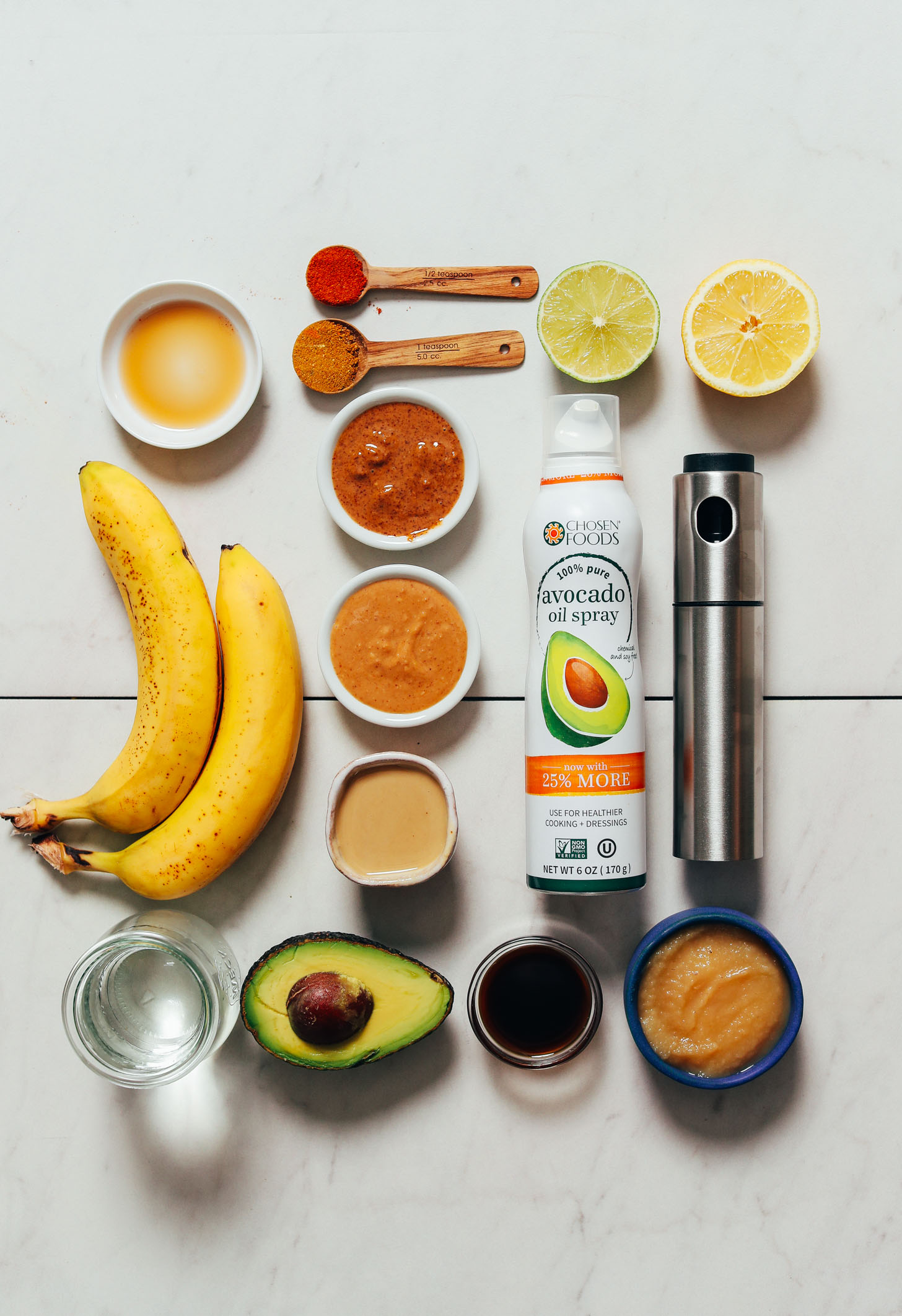
Recently, I’ve been experimenting with cooking with less oil. Not no oil, per say, but certainly less. Mainly because it’s somewhat of an experiment and challenge for me, but also because there may be health benefits to reducing consumption of oils.
Why No Oil?
I’m well aware that a decent portion of our audience adheres to a whole foods plant-based diet, which generally does not advocate for the use of oils in cooking. Why?
The primary argument is that oil is not a “whole food.” It’s a processed byproduct of a whole food. Avocado oil, for instance, is extracted from avocado, and olive oil is extracted from olives. While those are whole foods that contain fats, when eaten in extracted form (oil) they are no longer considered a whole food. Is that a problem?
What do the Experts Say?
While there are mixed perspectives on whether or not oils have a place in a healthy diet, one of the more influential voices on this topic in the plant-based world is Dr. T. Colin Campbell, author of The China Study.
Campbell’s primary argument in the oil-free debate is that plant oils have experimentally been shown to promote cancer much more than saturated fats. “In my opinion, this is a primary reason for avoiding consumption of added oils,” says Campbell, adding, “another reason for avoiding these oils is their contribution to total calorie intake which displaces, in effect, the consumption of calorie containing whole, plant foods”. (source)
In other words, oils are calorie dense. From a whole foods plant-based perspective, there’s more nutritional benefit to eating the olives — which contain more iron, copper, calcium, and fiber – than consuming olive oil.
However, there are many points of view on the subject of oil in our diet. Dr. Mark Hyman, for instance, discusses the importance of moving away from inflammatory fats and achieving a more balanced intake of omega-6 vs. omega 3 fatty acids.
It’s also important to recognize that a low- or no-oil diet may not be suitable for everyone. While it could result in consuming more of certain vitamins and minerals from whole food sources, it could also lead to not consuming enough calories or other nutrients. This is especially relevant for those who have a tendency to under-eat or who are experiencing food insecurity.
I’m personally not siding with any one expert in particular. However, I have found it a fun challenge to cook with less oil and something worth trying as our readership does ask for oil-free options regularly.
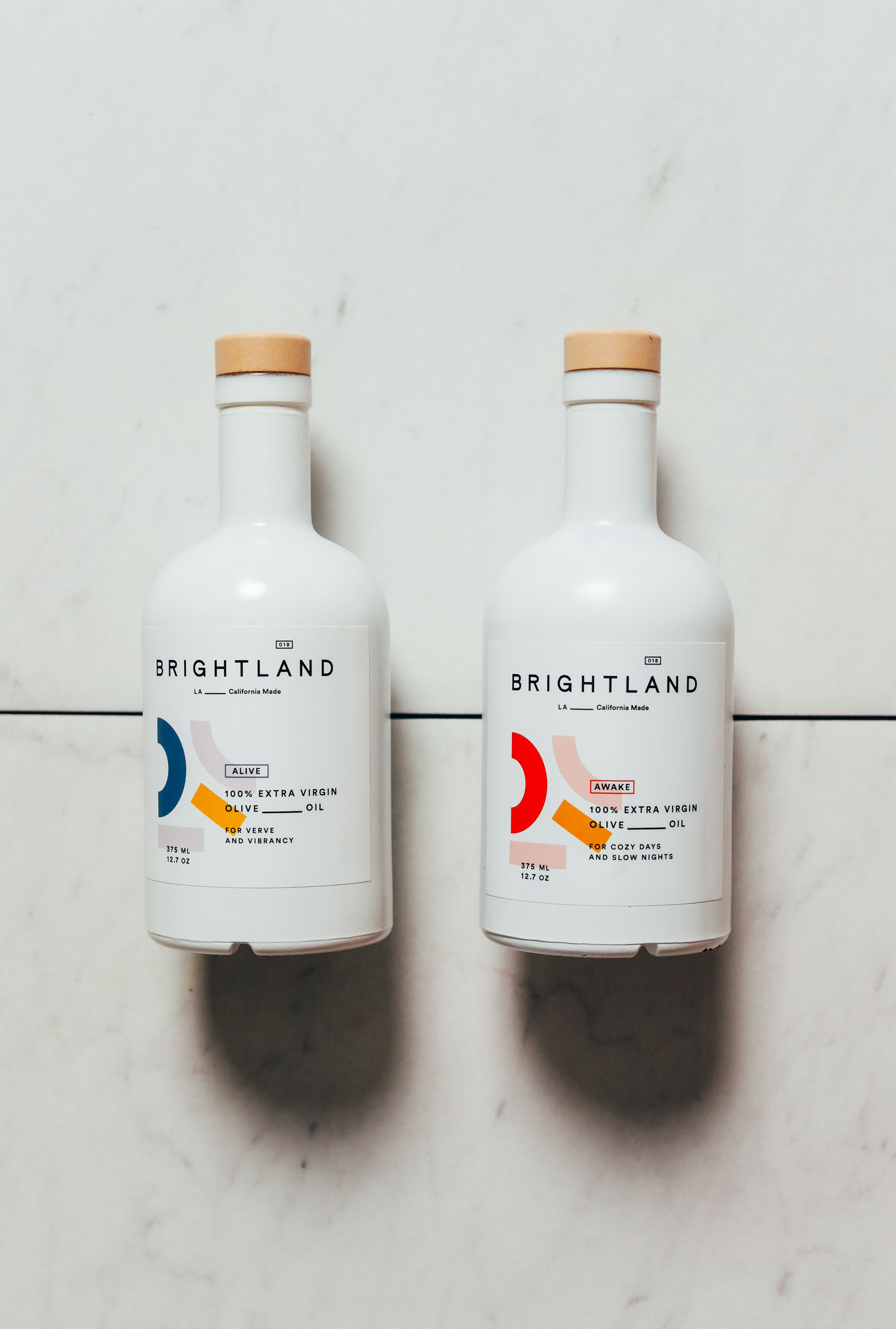
Is Olive Oil Healthy?
By the way, isn’t olive oil supposed to be the one oil that’s indisputably good for us? It is a part of the health-promoting Mediterranean diet after all.
I found this alternative perspective from Dr. Michael Greger interesting, which suggests the perceived benefits of olive oil may not be as clear cut as we think. There’s also this article arguing for olive oil from Healthline.
My Approach
Personally, I choose to consume some oil in my diet (avoiding it altogether seems nearly impossible, especially considering I travel and eat at restaurants). But when I do consume oil, I always try to select the highest quality oils possible and use them in limited quantities.
For instance, I’ve been using Brightland olive oil, which is incredibly flavorful and high quality (not sponsored, just love). I use it to dress my salads, and the best part is you don’t need much because the flavor is so fresh and potent. And when I need a little oil for sautéing or roasting, I generally opt for avocado oil.
How to Cook with Less Oil
So, maybe you’re curious and want to start experimenting with cooking with less oil but don’t know where to start. Are we really supposed to give up our vinaigrettes on salads, forgo caramelized onions, and have dried out baked goods? Fortunately, the answer is no.
In this guide I’ll walk you through what I’ve found to be some great hacks for cooking with low/no oil without sacrificing flavor or texture, as well as share some of our favorite oil-free recipes! Let’s get started!
Roasting
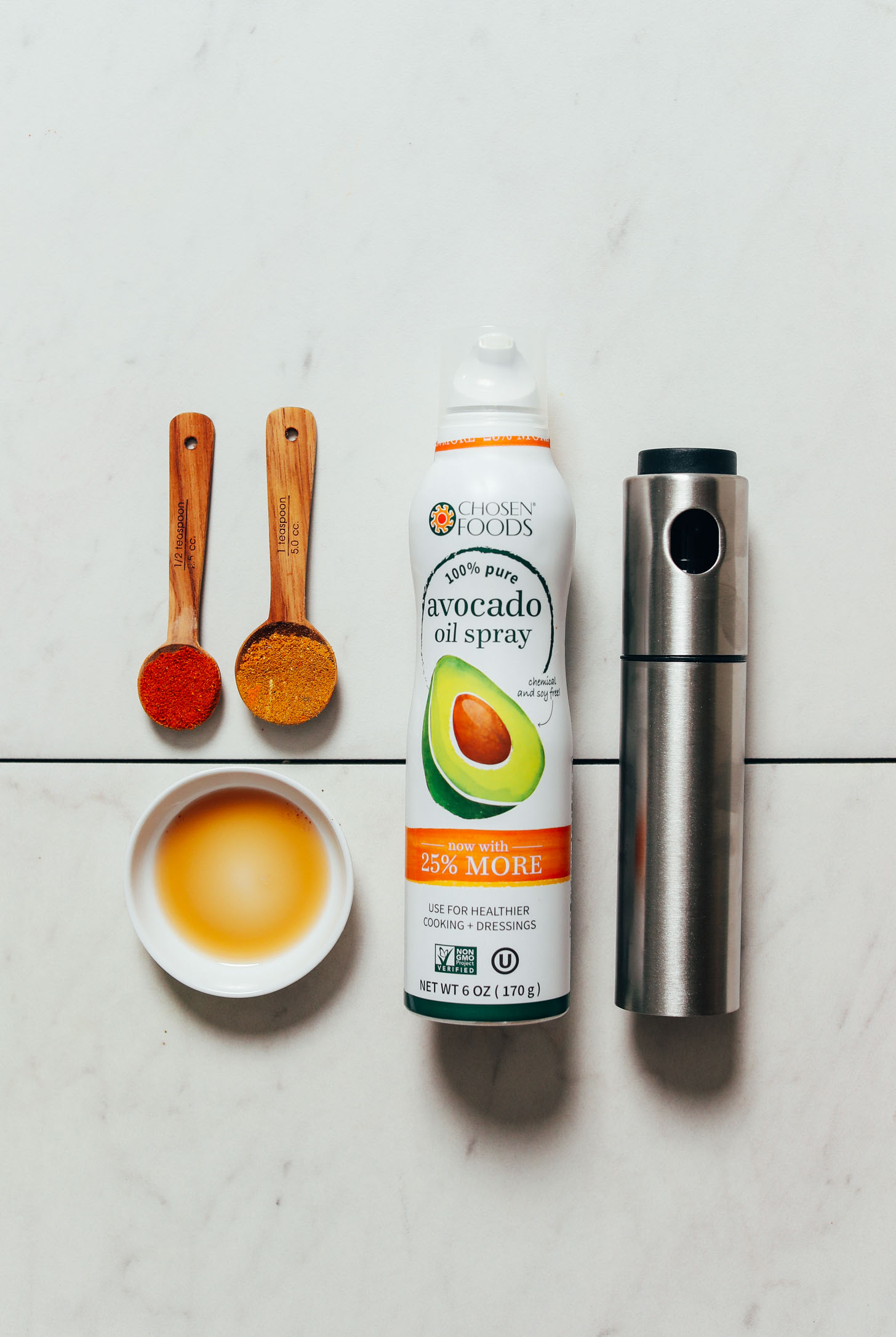
- Low Oil: My go-to technique when cooking with less oil while roasting is to spritz my veggies with a little avocado oil (either a store-bought can, or this spray bottle from Amazon) instead of tossing with tablespoons of oil. Right away, this means you’re evenly coating your ingredients — but with far less oil.
- Low Oil: My second tip is to use a spritz of oil along with maple syrup, which helps your ingredients (especially vegetables) caramelize. I also add in spices to taste (such as sea salt and our go-to curry powder or shawarma spice blend) for more flavor. This creates a tender texture with slightly crisp edges and plenty of balanced flavor!
- Oil-Free: If you’re looking to roast completely oil-free, your friend will be steaming or boiling your ingredients prior to roasting (see photo below), which adds moisture on the front end of cooking, and also cooks your ingredients mostly or all the way through so they won’t get dried out over-baking in the oven. Then, all that’s left to do is add your seasonings of choice and roast on a high temperature (375-425F or 190-218 C). Also, rely on the convection setting if you have it to get your ingredients browned with crispy edges. See this recipe for oil-free roasted vegetables for the full guide.
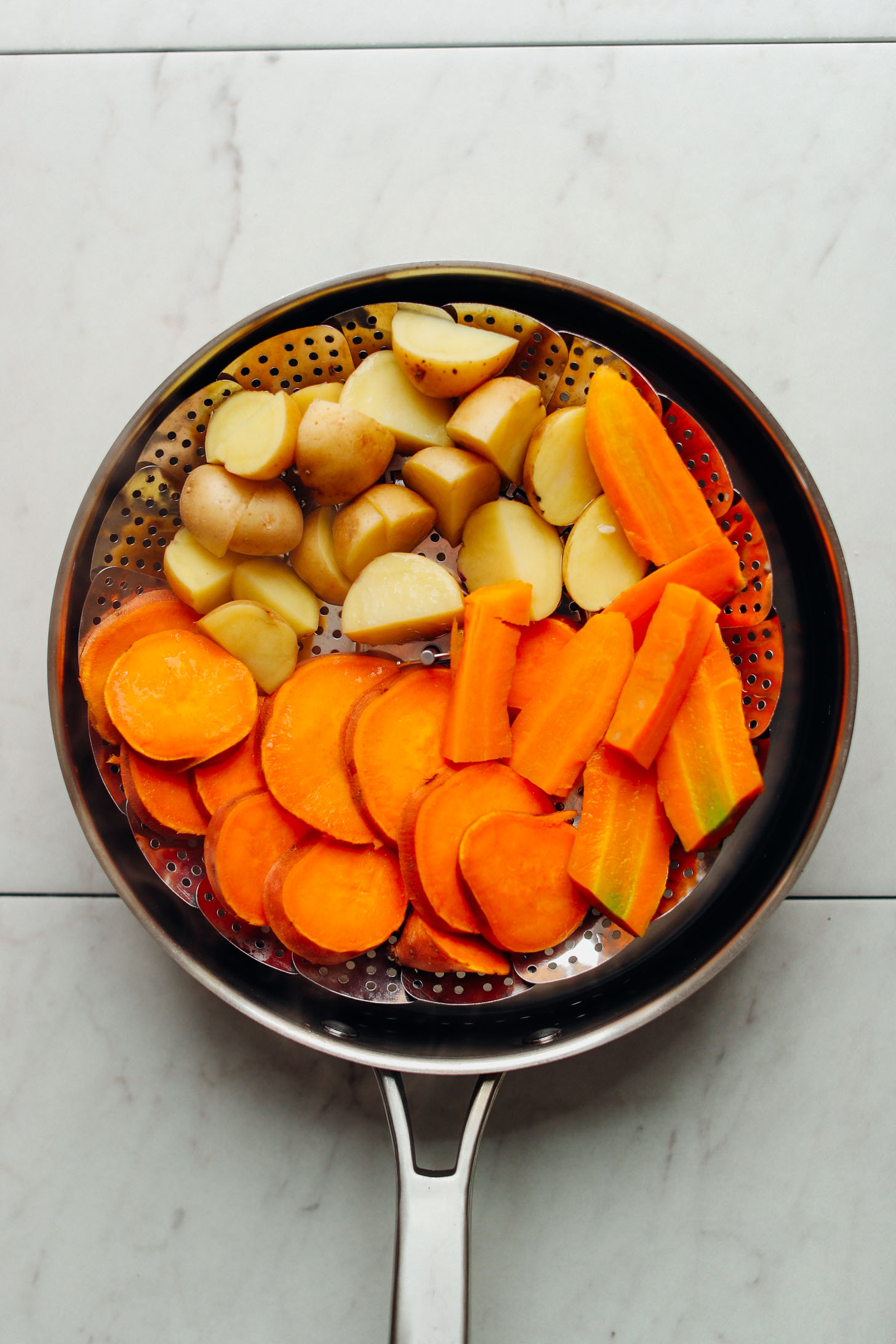
Sautéing

- Low-Oil: Again, a spritz of oil in your pan will go a long way — and you’re using far less than you would when pouring oil in from a bottle. This technique can also be accompanied by adding a little water as you continue cooking to keep the ingredients from sticking. This can also be done with broth or coconut aminos (or soy sauce). Just know that broth and coconut aminos do add flavor.
- No Oil: Rely on water or broth to sauté ingredients like diced vegetables, onions, and garlic. You’ll need to continue adding a little broth or water at a time to keep the ingredients from sticking to the pan, but it does work (see photo below)! A perfect example of this technique is our 1-Pot Smoky Lentil Vegan Taco “Meat”!
- No Oil: A technique I learned from Thai cooking is to use the fat in coconut milk to sauté your vegetables. Find a great example of that in our 1-Pot Vegetable Green Curry, which I adapted from Hot Thai Kitchen.
- No/Low Oil: Non-stick cookware also allows for oil-free / reduced-oil cooking due to its slick nature, which naturally doesn’t allow foods to adhere to the surface. Although it may not get food quite as crispy and caramelized, it is another good option if looking to reduce or remove oil from your diet. I admittedly haven’t found a durable non-stick, non-toxic pan that I wholeheartedly recommend yet (currently testing the Always Pan, which is non-toxic). So if you have one you love and use, let us know in the comments!

Stews, Soups, and Curries
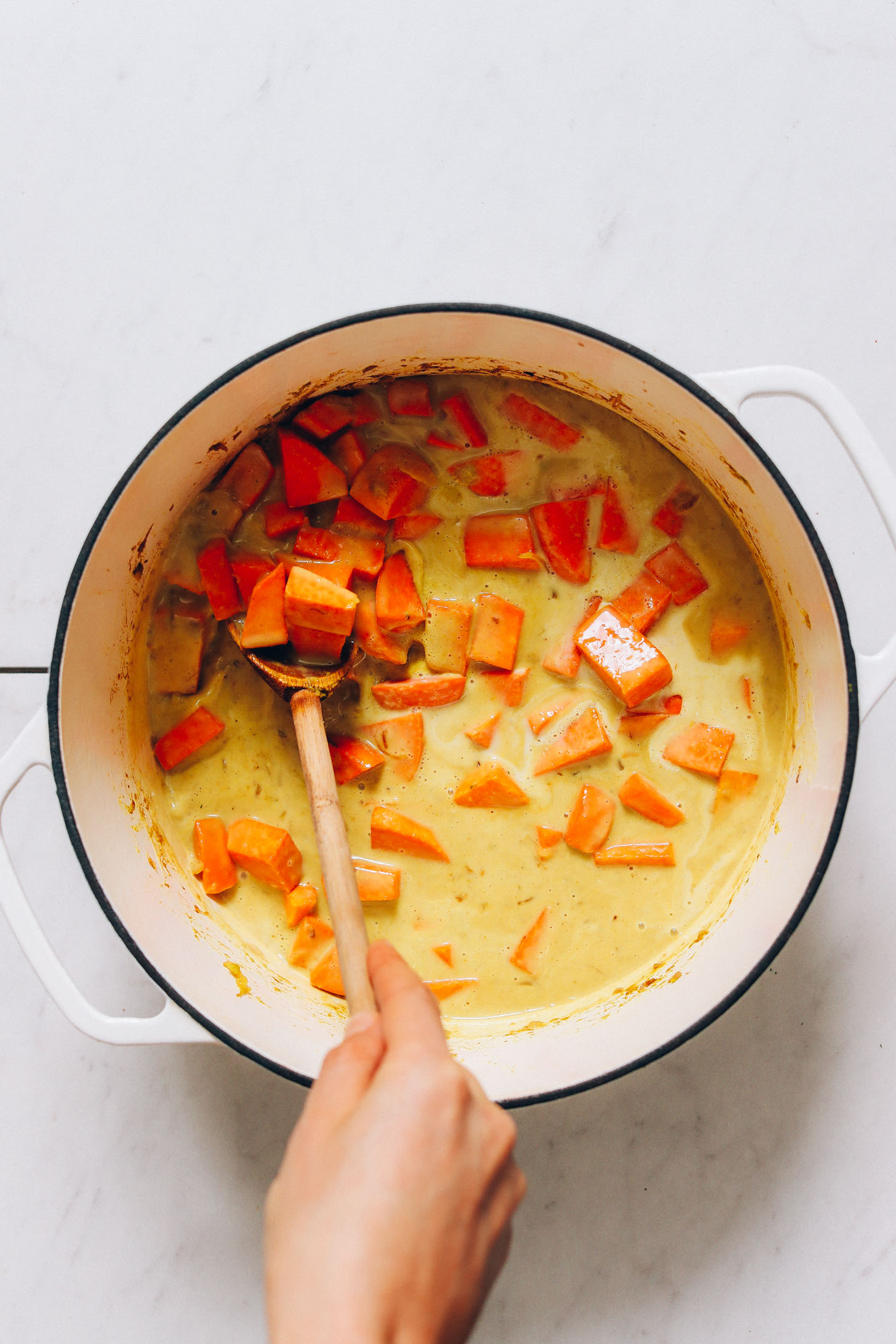
- No Oil: Perhaps the easiest of all the categories! Simply sauté your ingredients in water or broth (for soups and stews), or coconut milk (for curries) before adding your other ingredients. This works because you’ll be adding additional liquid to cook your ingredients later anyway, namely water, broth, or coconut milk. A perfect example of this is our Creamy Curried Cauliflower Lentil Soup, which easily utilizes water in place of oil for sautéing!
Baking
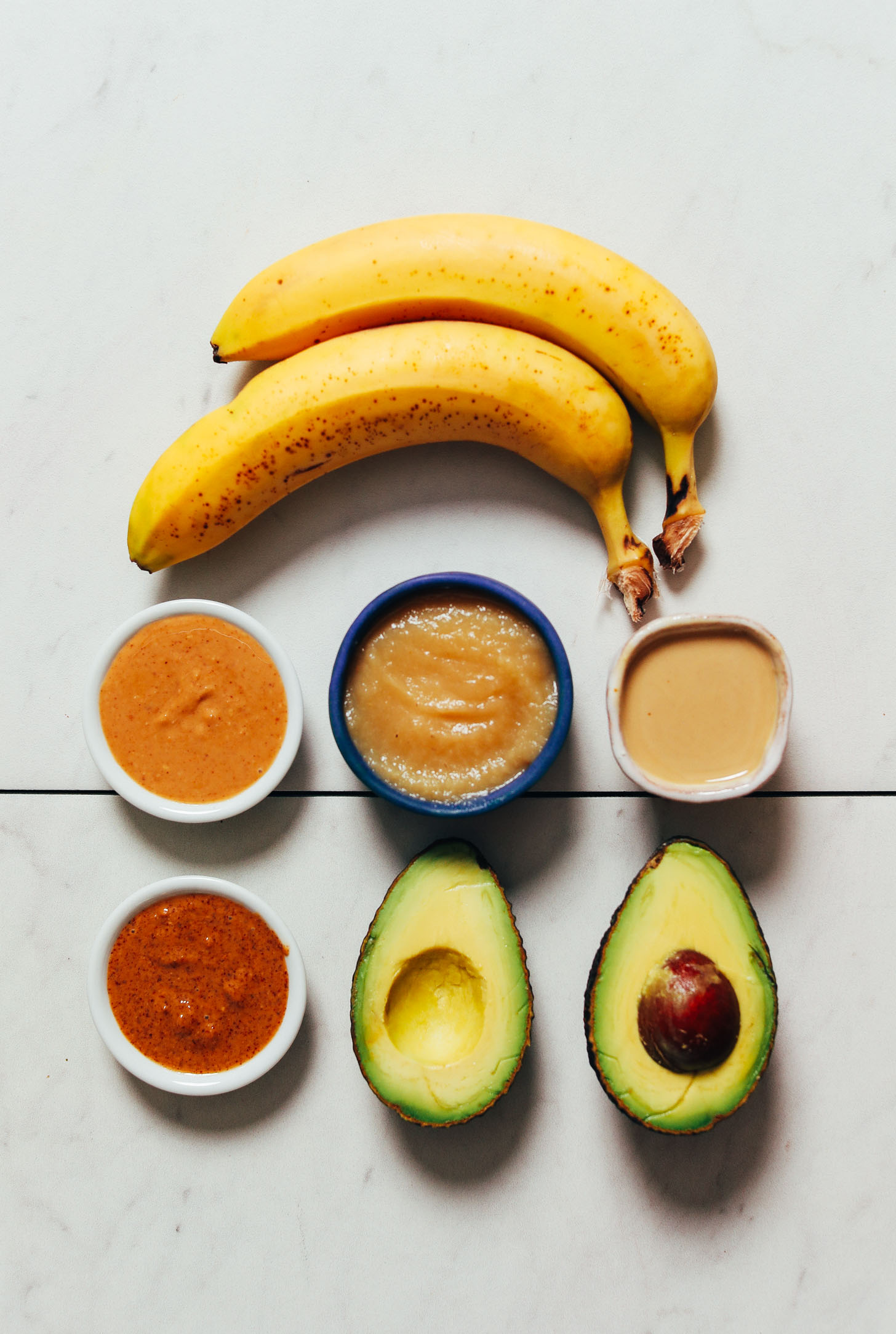
In baking you do still generally need some fat, otherwise your cookies may lack crisp, golden brown texture, and cakes and quick breads may turn out dry and crumbly. Here are some great alternatives to oil in baking:
- Mashed avocado – adds moisture and fat; ideal for quick breads and cakes.
- Dairy-free yogurt – adds moisture and fat; ideal for heavier cakes and quick breads.
- Nut or seed butter – adds moisture, fat, and can help crisp; ideal for quick breads, muffins, cookies, and granola.
- Mashed ripe banana – adds moisture and helps bind; ideal for quick breads, cakes, and even granola.
- Applesauce – adds moisture; ideal for cakes, quick breads, and muffins.
- Less Oil: Sub 1/4-1/2 of the oil in your recipe with one of the above mentioned ingredients for some of that familiar taste and texture oil provides without going completely oil-free!
TIP: When in doubt, a combination of two oil-free substitutes is usually a good idea so one ingredient isn’t shouldering the burden of the substitution. For instance, in place of 1/4 cup olive oil, you may sub 2 Tbsp mashed banana and 2 Tbsp mashed avocado. Or in place of 1/4 cup vegan butter, you may sub 2 Tbsp nut butter and 2 Tbsp applesauce or mashed banana.
Don’t believe oil-free baking is possible? Feast your eyes on the chocolate cake of our dreams. Try our Vegan Gluten-Free (Oil-Free) Chocolate Cake and let us know what you think!

Salad Dressings & Sauces

- Less Oil: Sub half the amount of oil you normally add with water or citrus, depending on the flavor profile you’re going for. For instance, a vinaigrette might look like 1/4 cup lemon juice, 2 Tbsp water, 2 Tbsp olive oil, and a pinch of salt and pepper. Recently, I’ve found an even more simple approach: Tossing my salads with lemon juice and seasonings such as za’atar adds more than enough flavor, and then I only need a drizzle of good olive oil for a little flavor and creaminess. No mixing or emulsion required.
- No Oil: Ditch the dressing altogether in favor of the simplest salad seasoning: Massage kale or toss romaine with a little maple syrup, citrus (lemon or lime), and seasonings of choice such as chili powder or curry powder and a bit of salt. My go-to recently has been lime, maple syrup, chili powder, and salt (photo below)!
- No Oil: Mash avocado or use guacamole as a dressing! Avocado is perfect for dicing and massaging into kale for a creamy dressing substitute.
- No Oil: Dress your salads with salsa or hot sauce. Add a dash of maple syrup and lime to balance out the heat!
- No Oil: When in doubt, tahini dressing. Use tahini or cashew butter in place of oil for a creamier, whole food dressing. You can also use a bit more tahini in place of olive oil when making dips like hummus and baba ganoush!
- No Oil: Omit the oil in our green curry paste and use it as a dressing! It’s also perfect for mixing with a little tahini, lime juice, and maple syrup for a creamy option, such as in this Curried Cauliflower Grape & Lentil Salad!
- No Oil: Another creamy oil-free dressing idea? Mix a little miso paste, rice vinegar, and maple syrup for a savory, salty, tangy dressing with serious umami! Inspired by our Miso-Glazed Brussels Sprouts!
Find more oil-free dressing and sauce ideas in the round-up below!

Recipes
Find our favorite oil-free (or oil-optional) recipes below! We’ve included sauces & dressings, entrées, sides, snacks, and desserts. Enjoy!
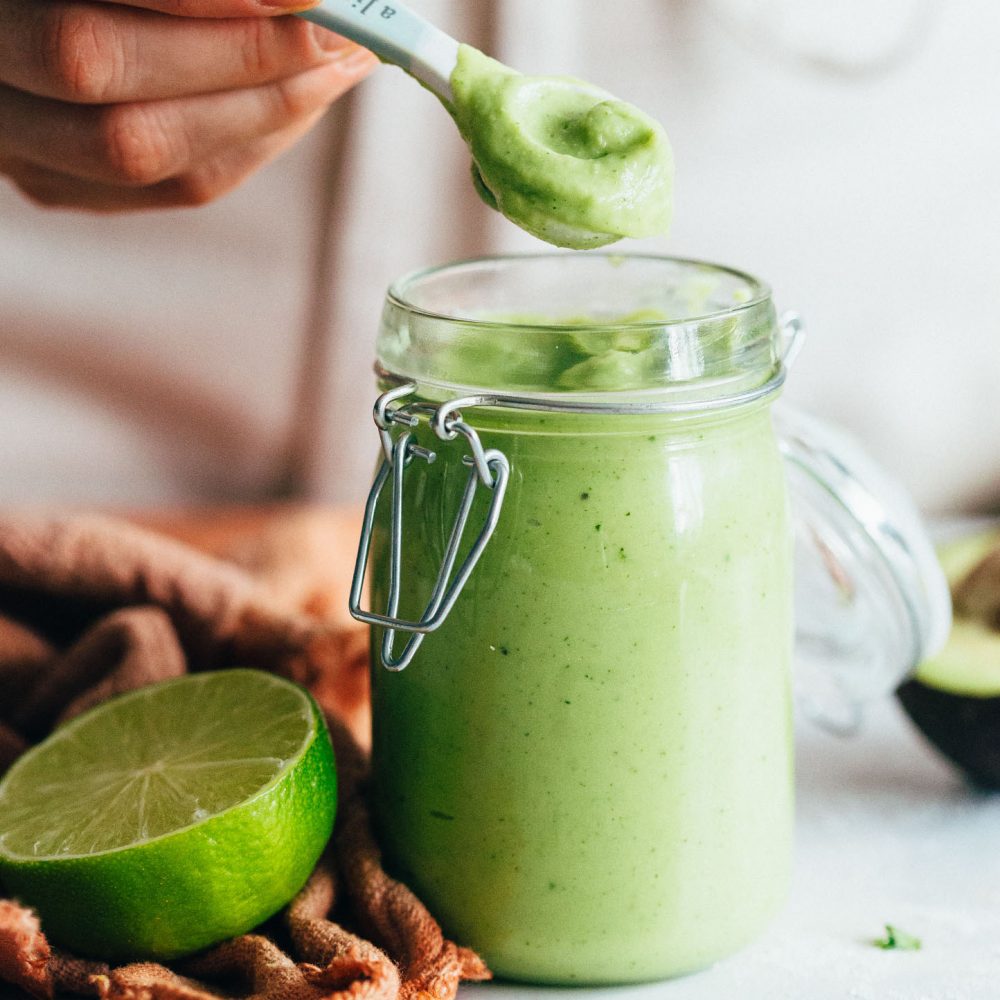
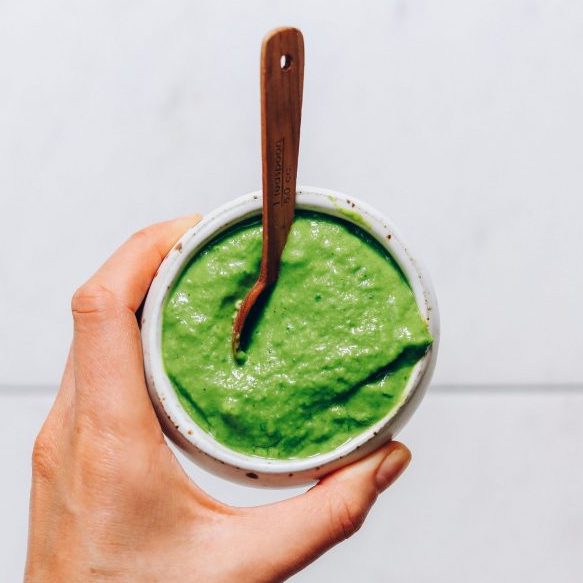
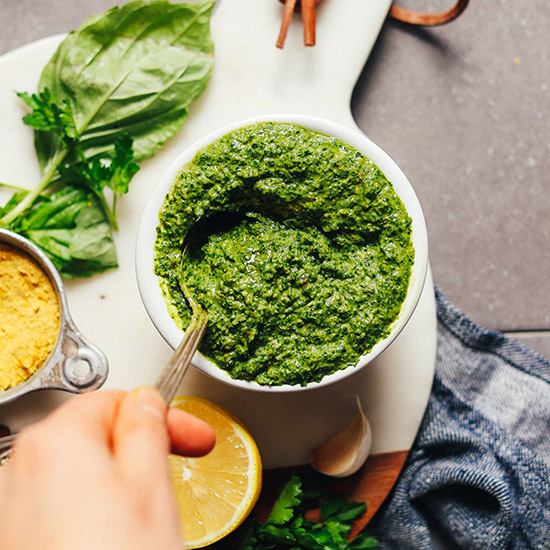
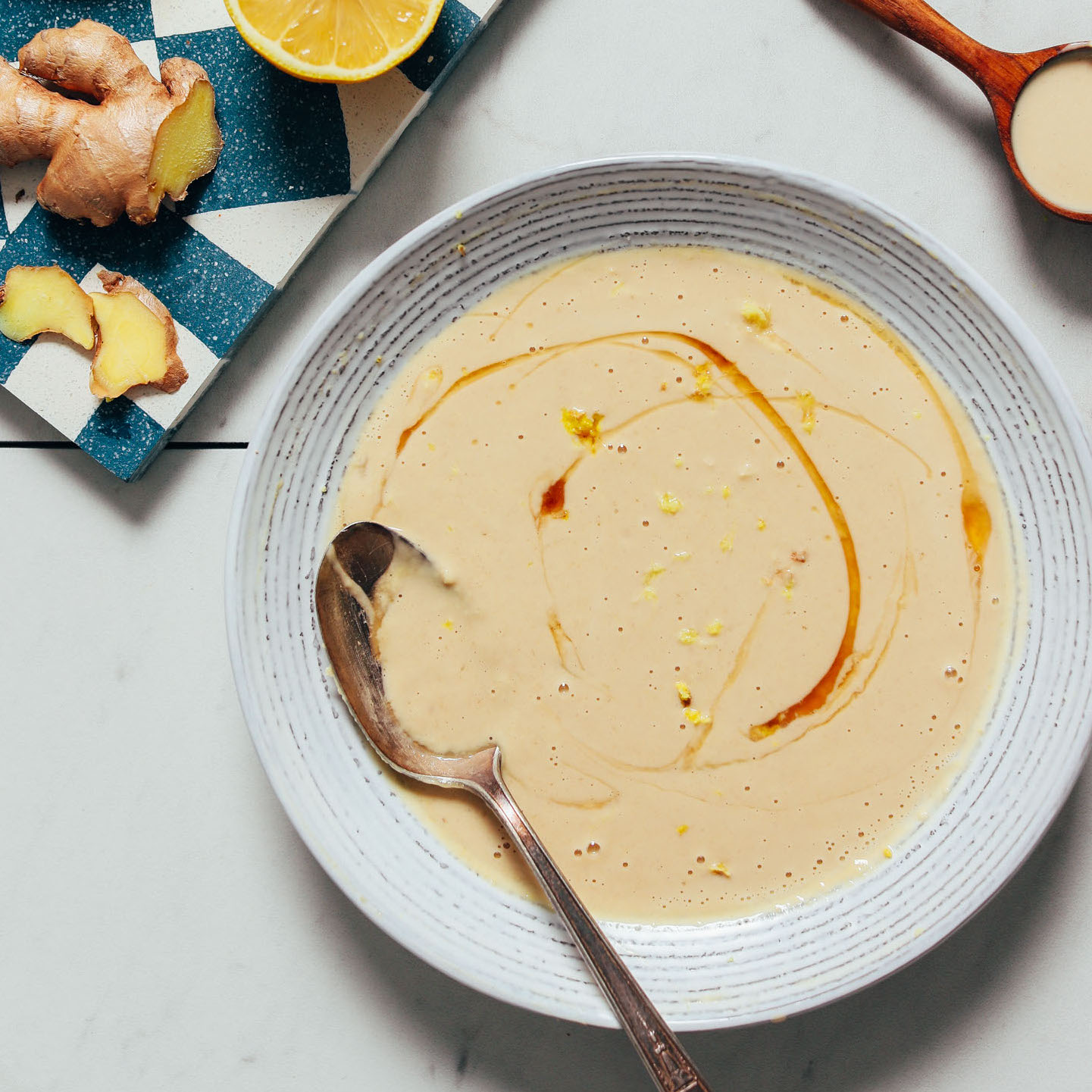
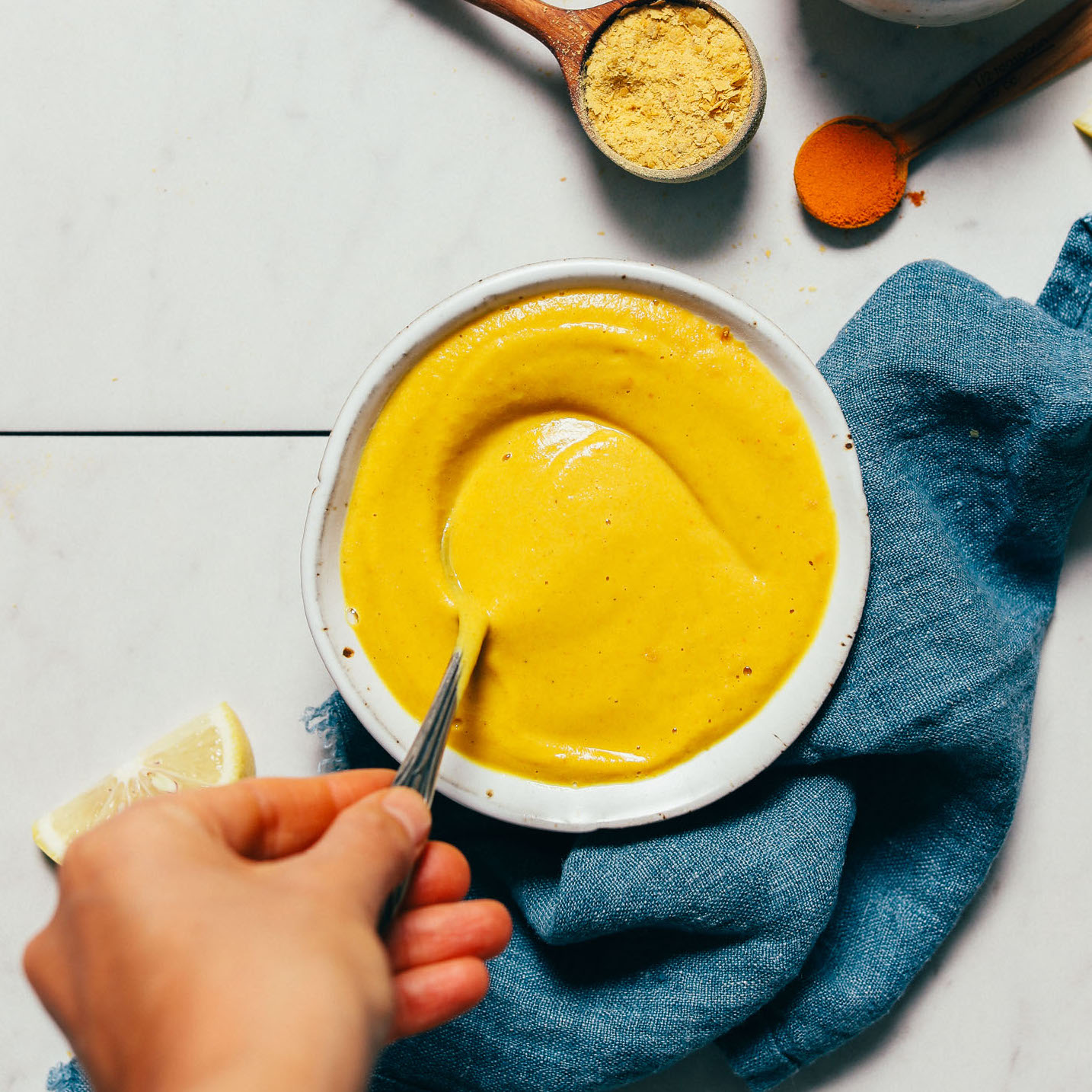
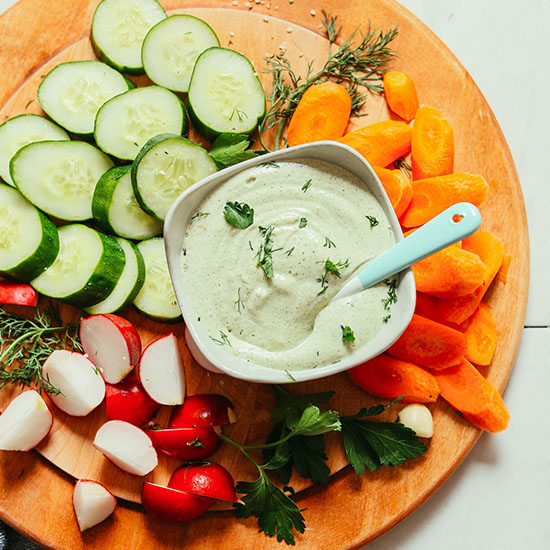
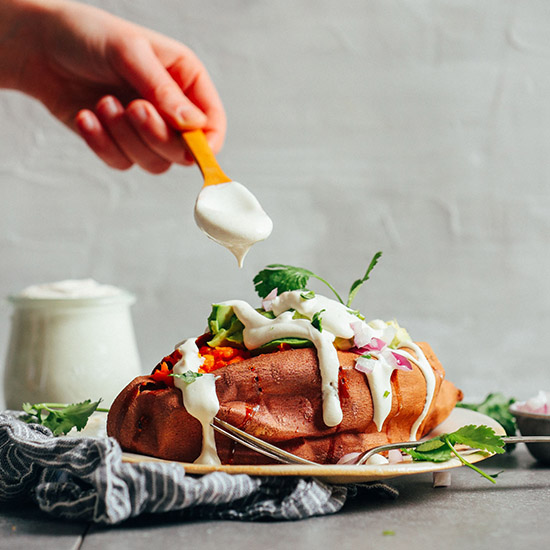
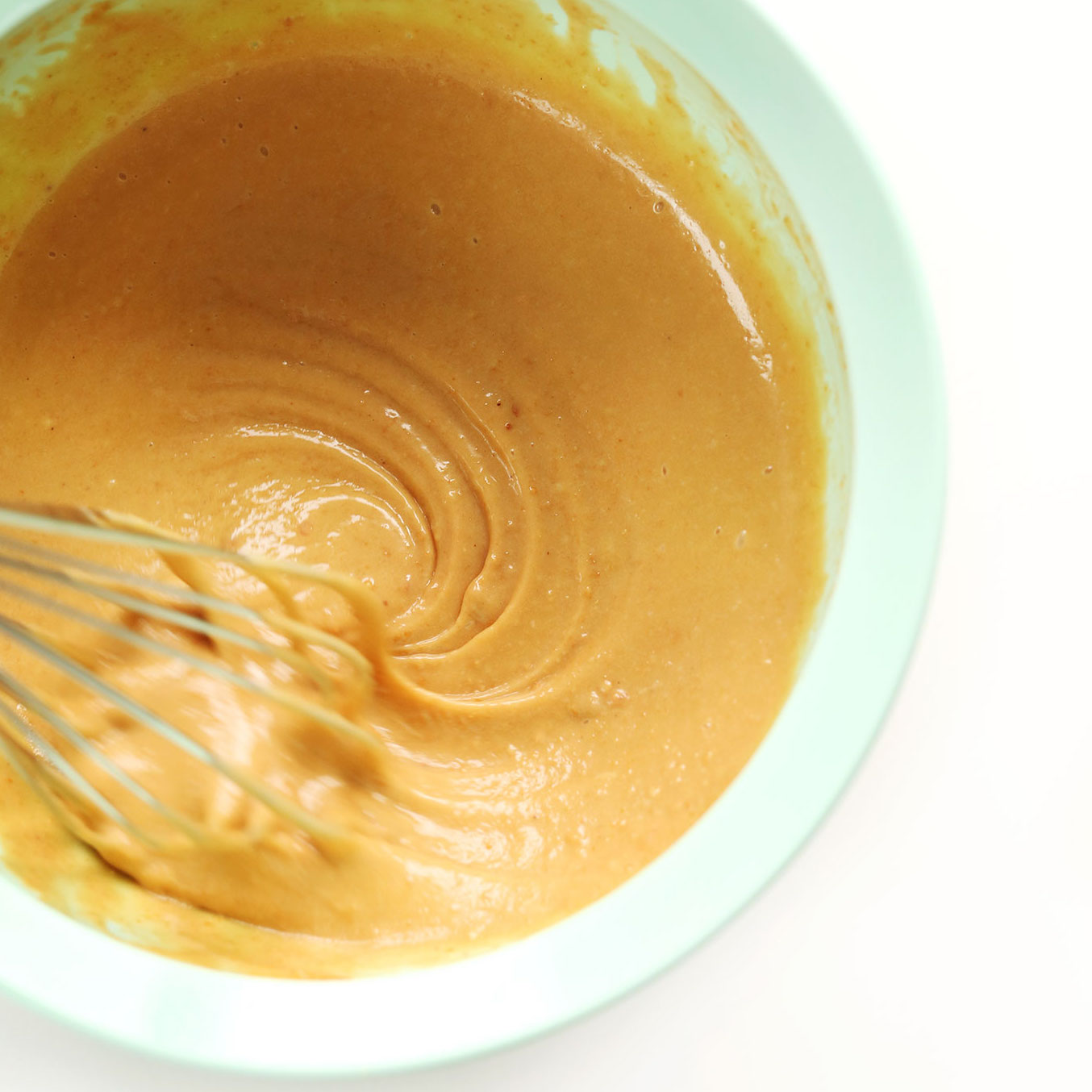
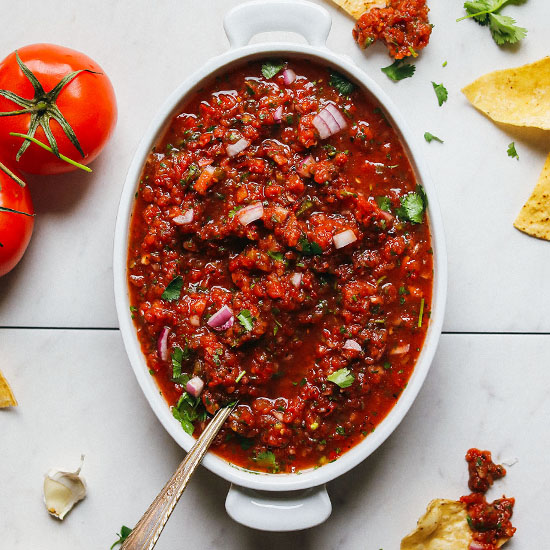


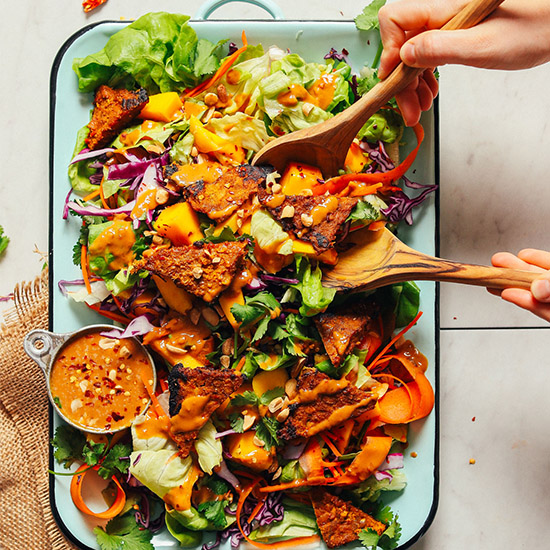
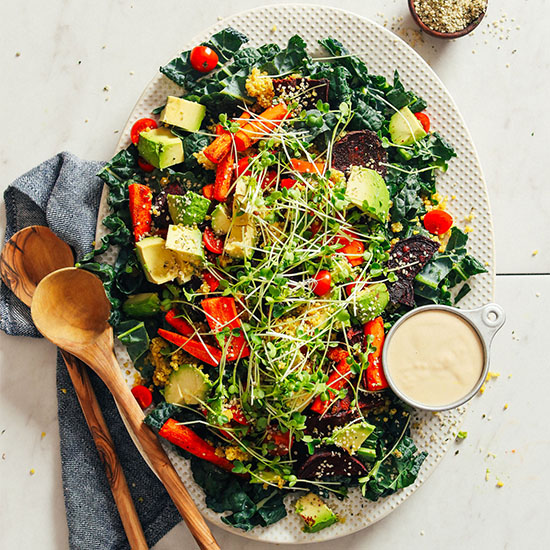
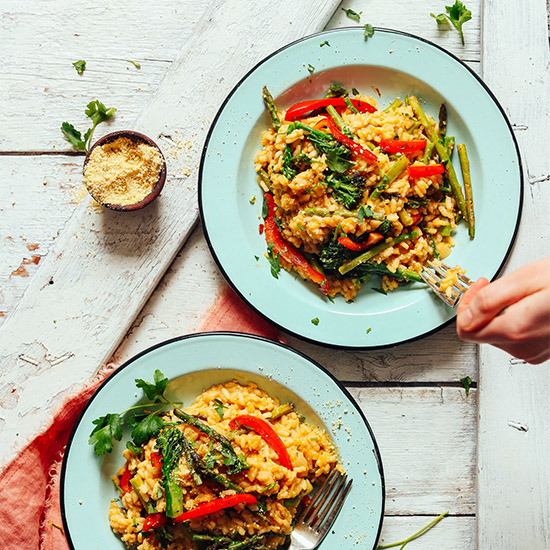
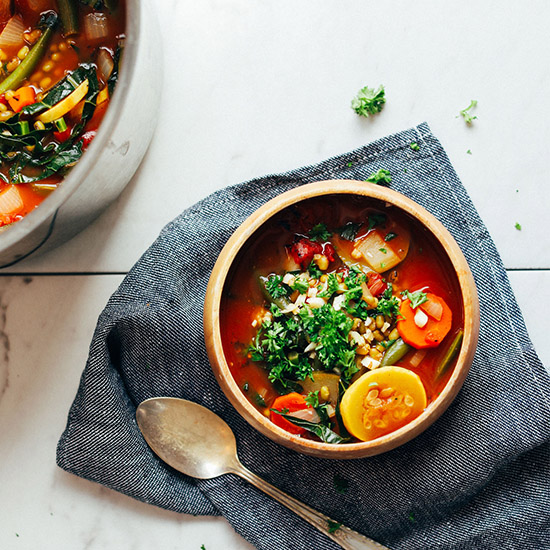
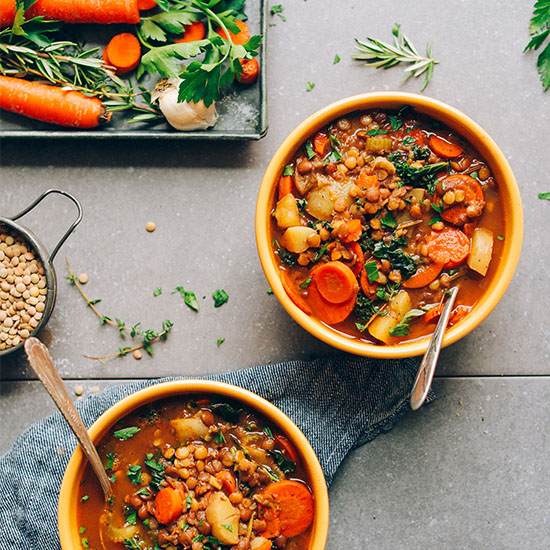
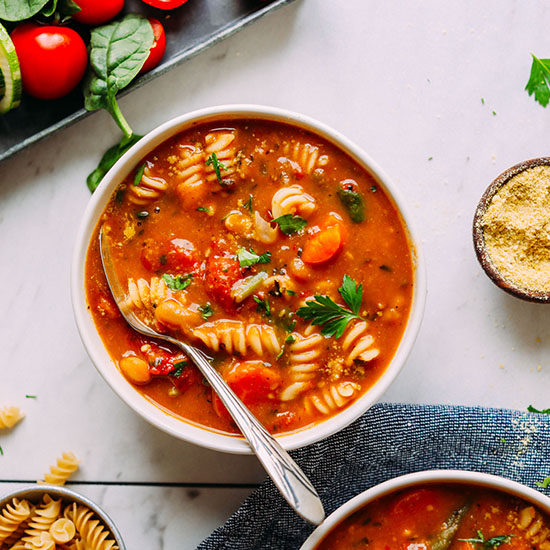
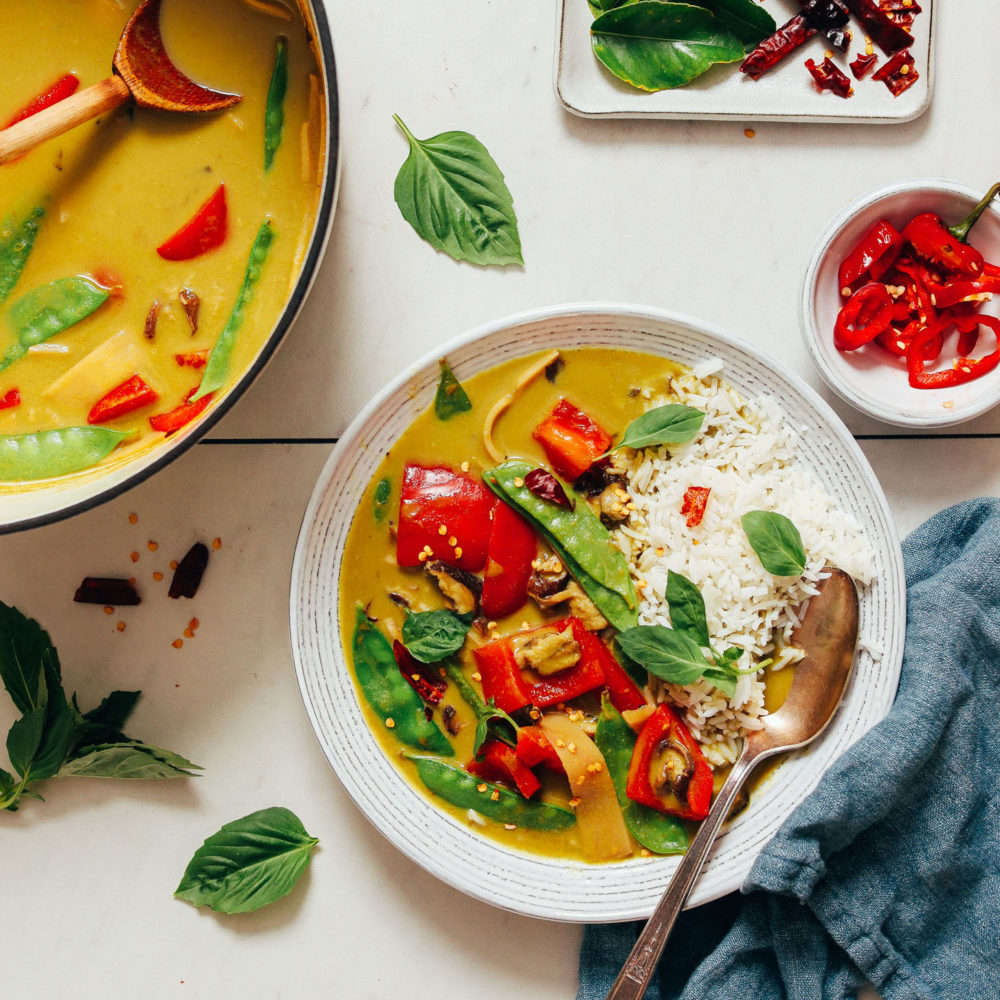

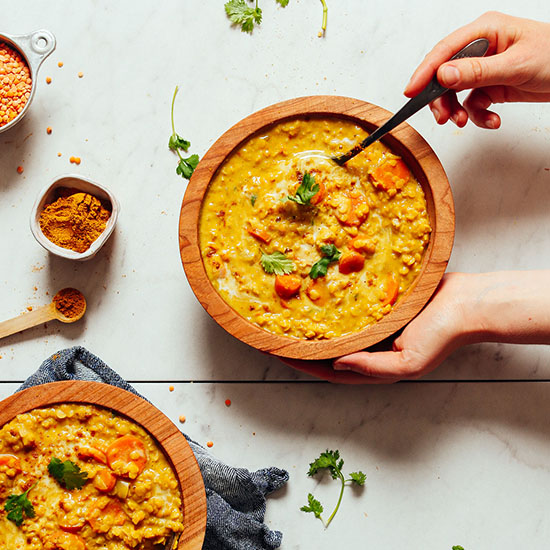

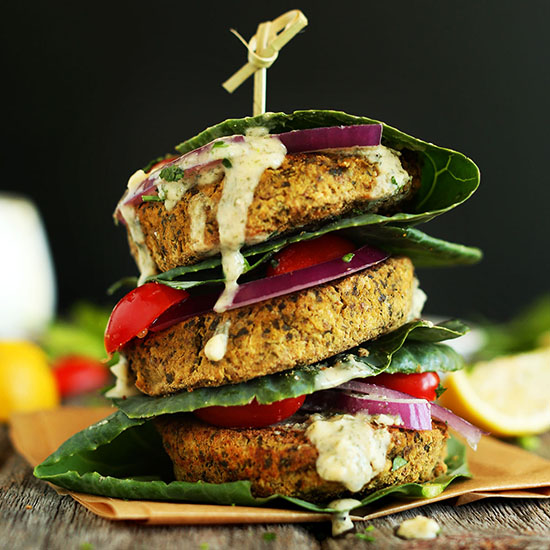
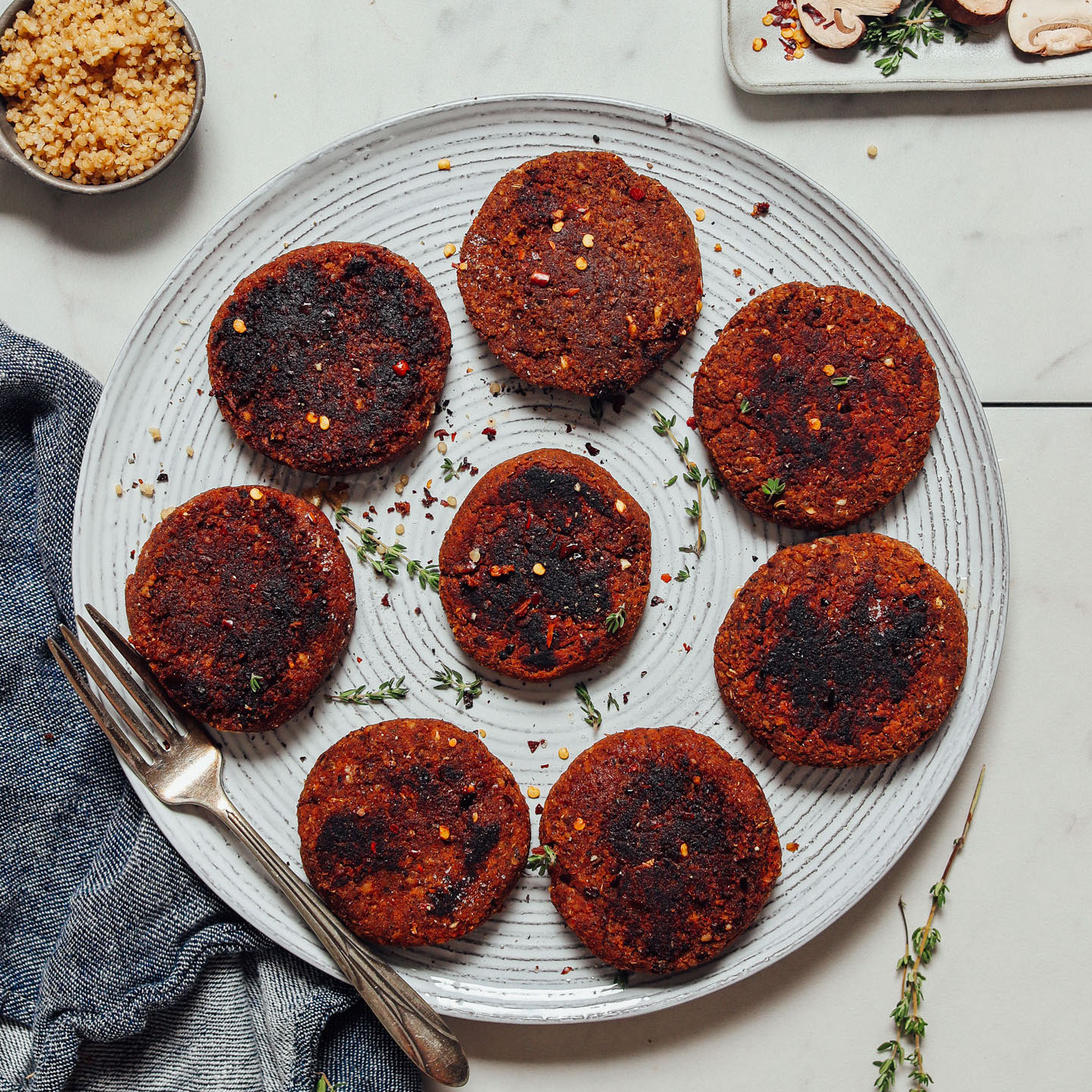
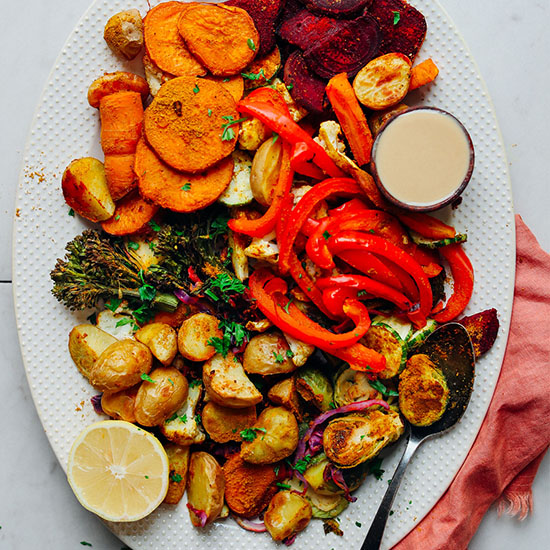
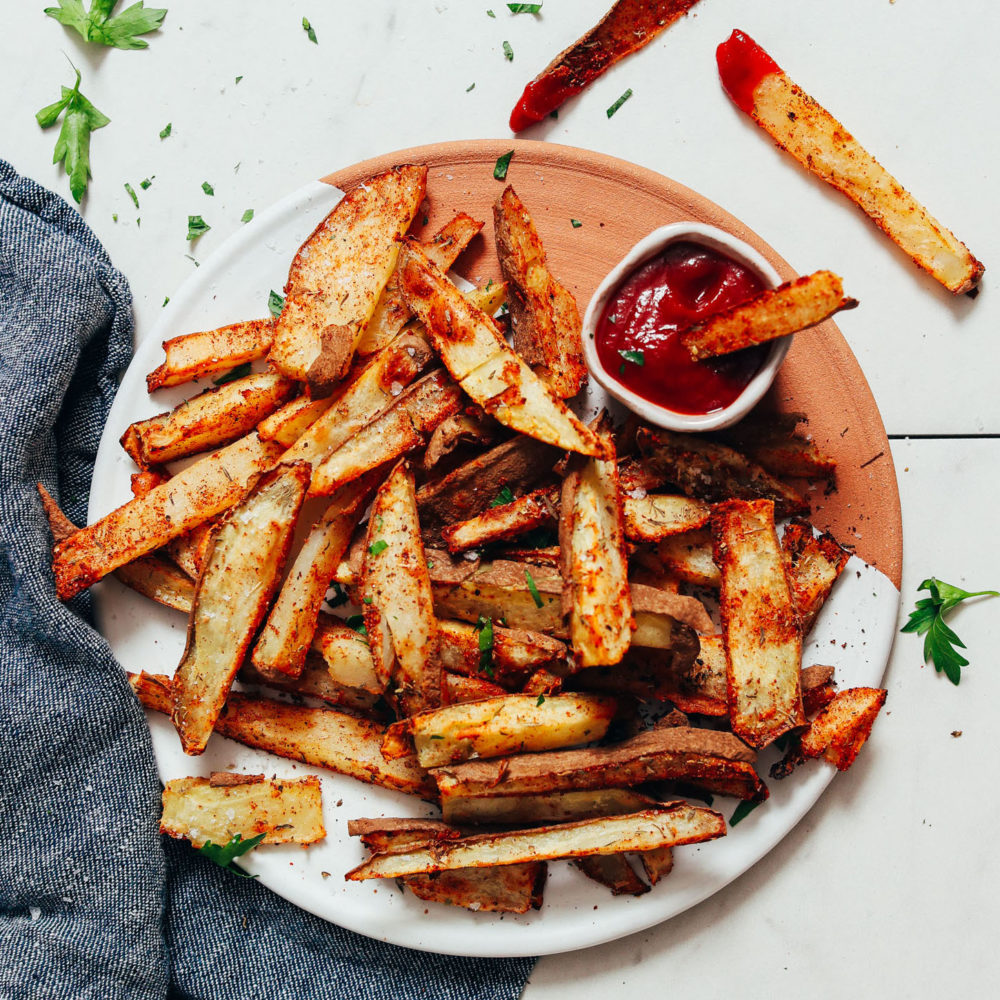
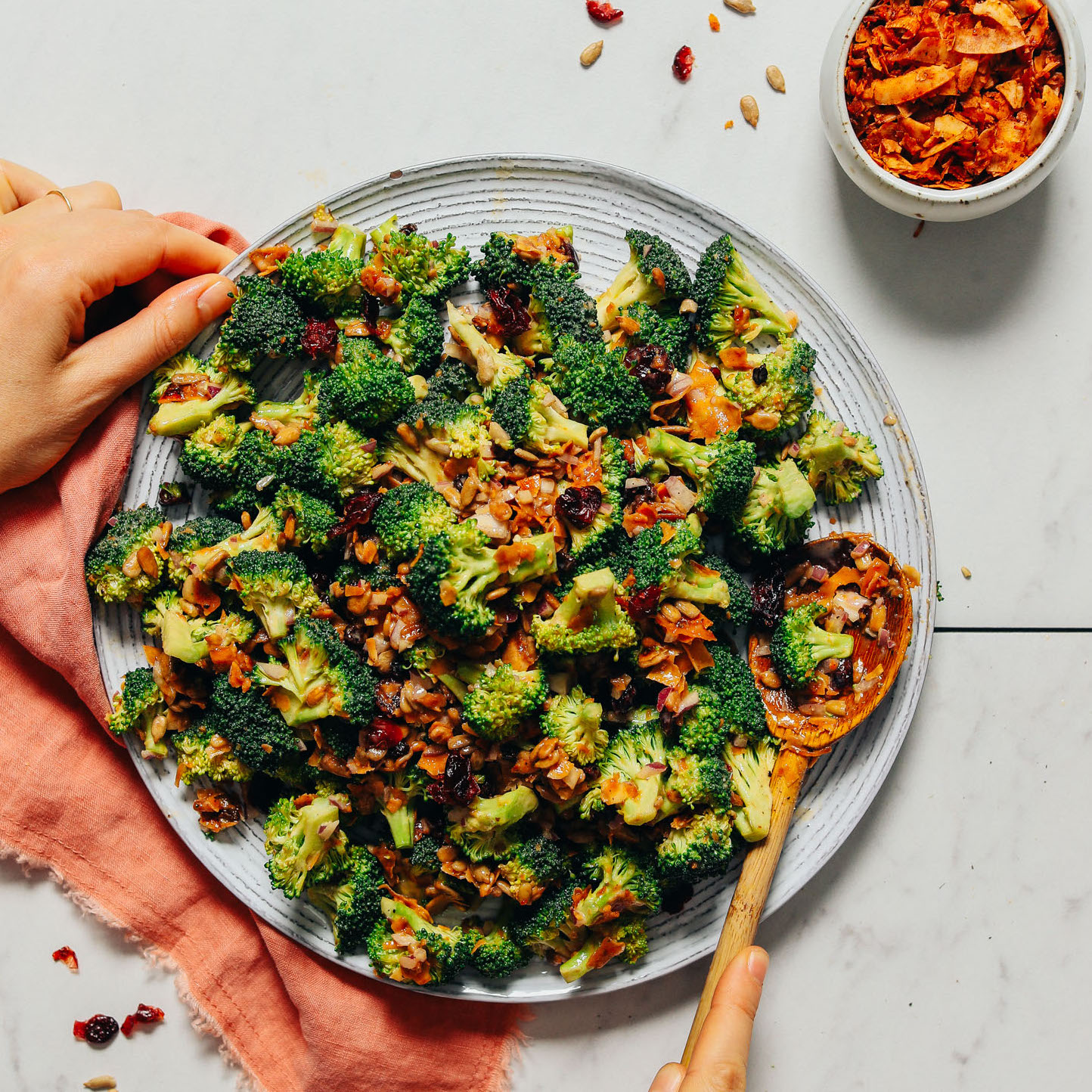
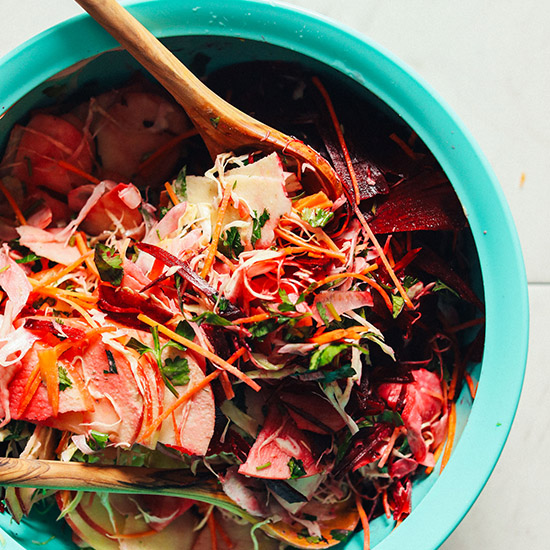
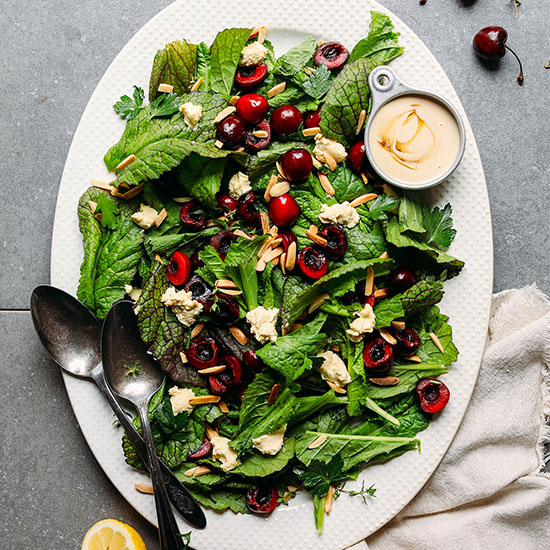
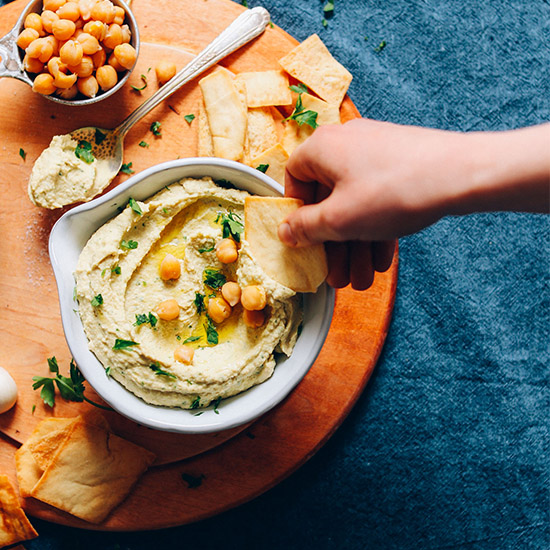
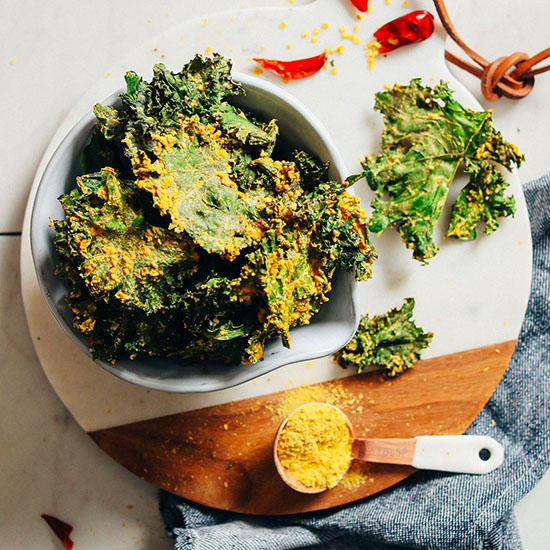
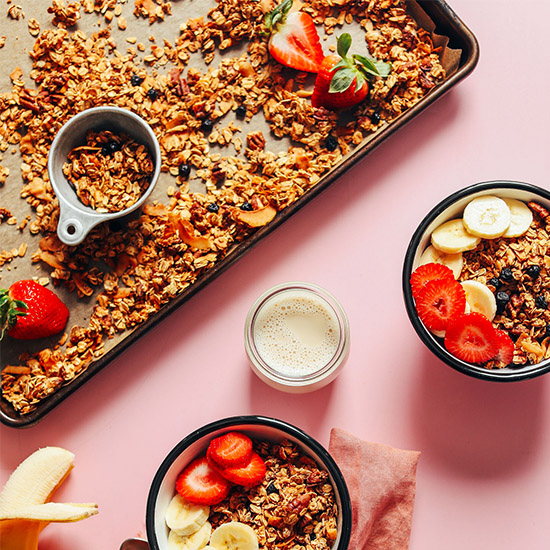

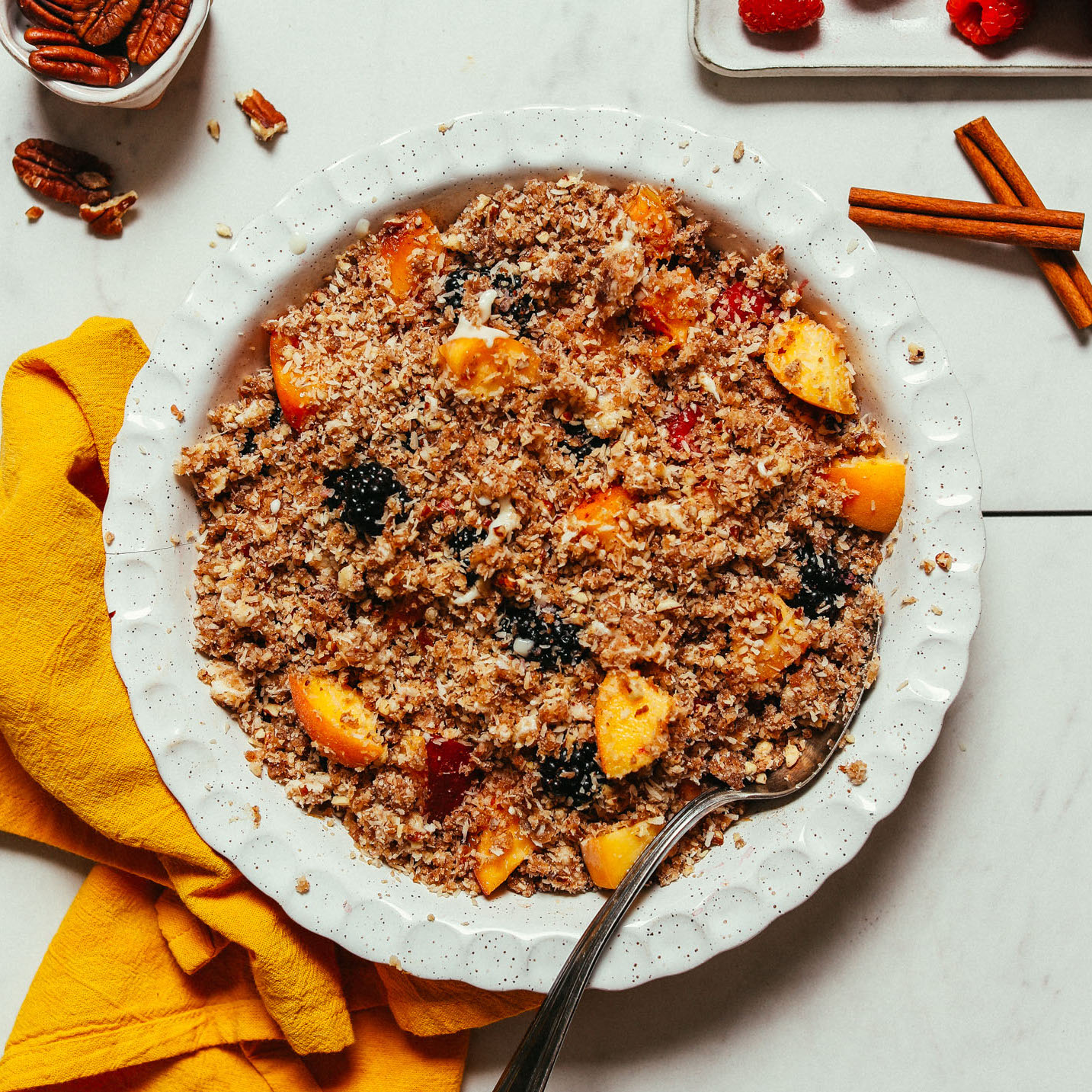
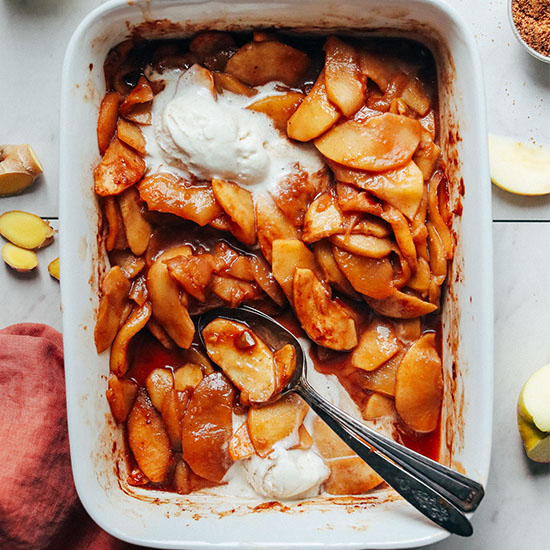

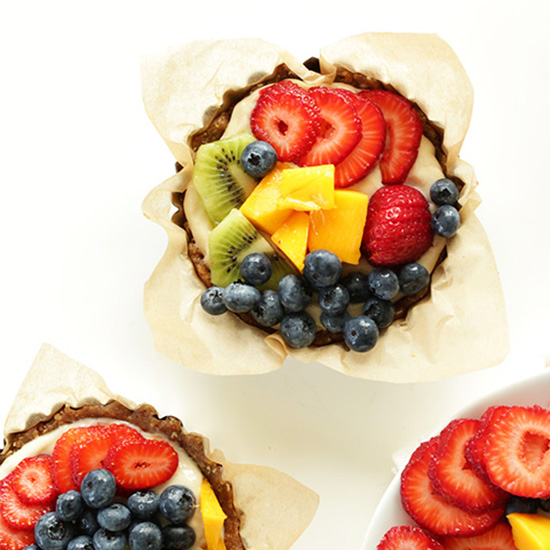
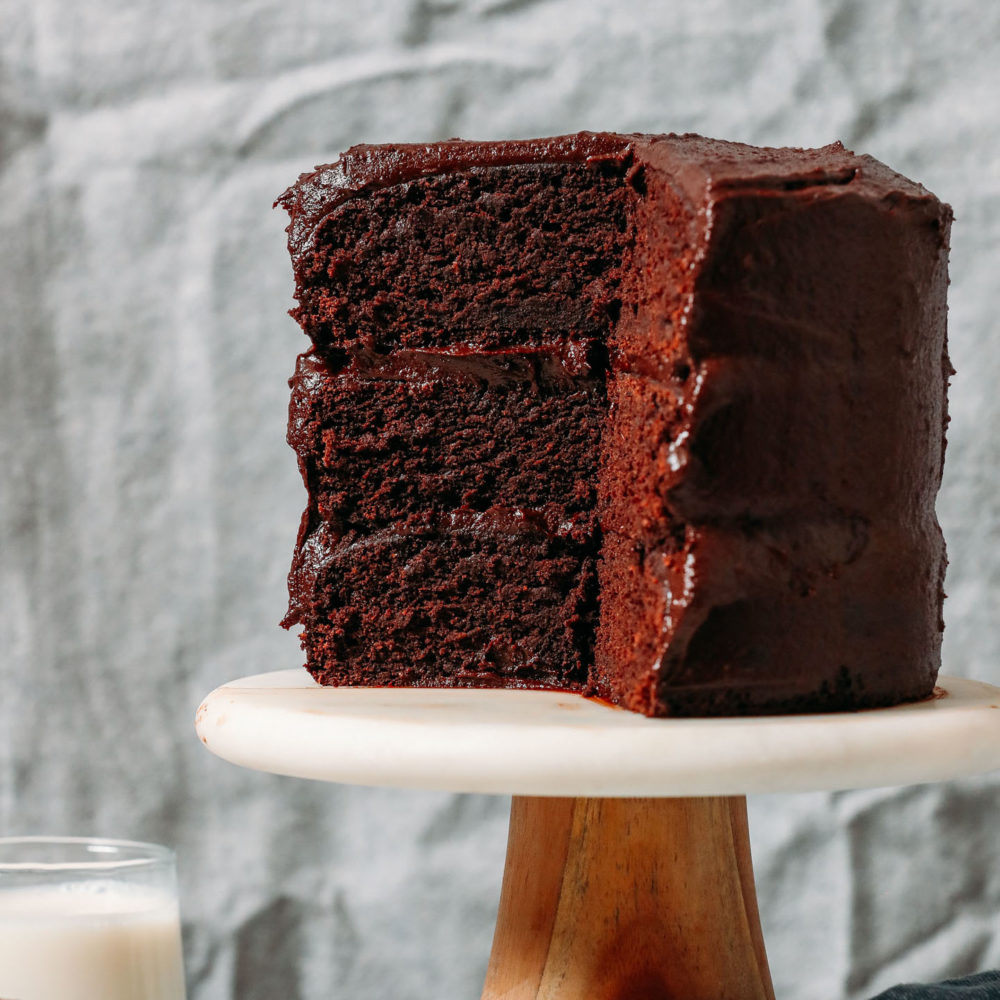

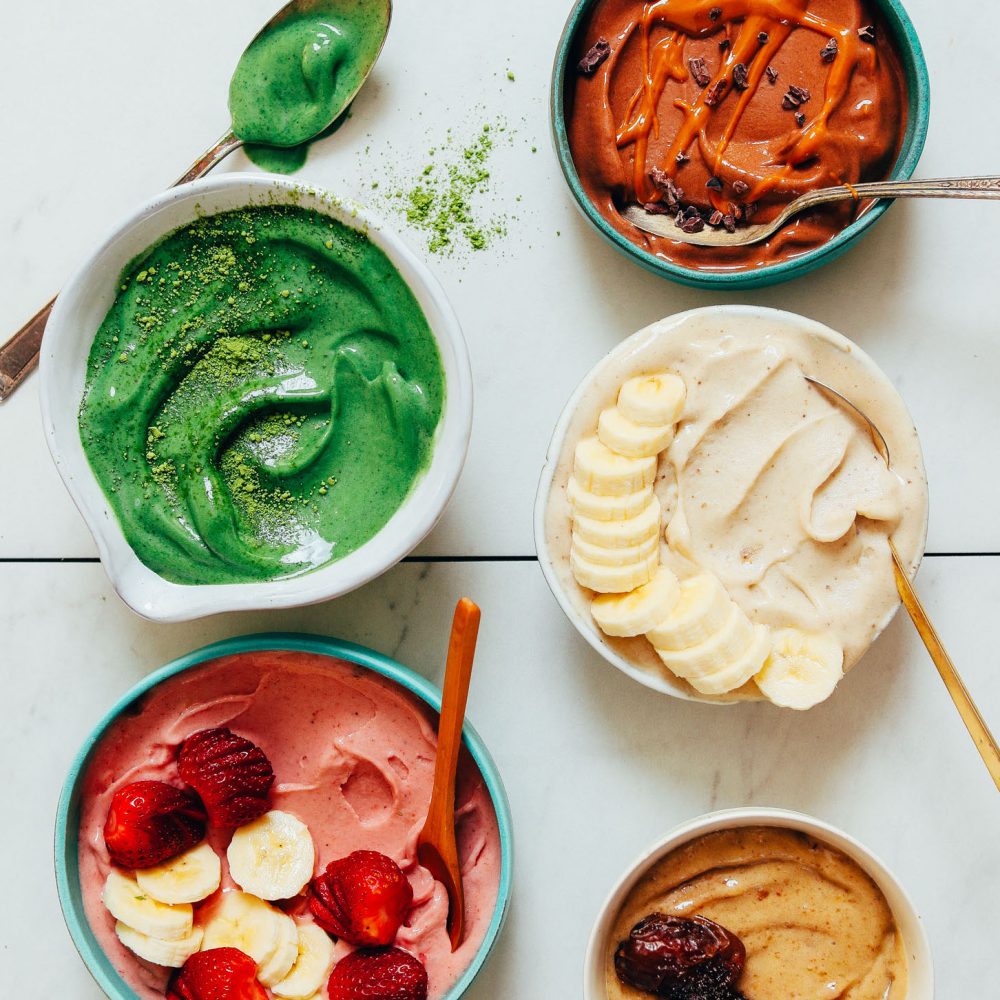
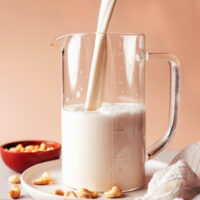
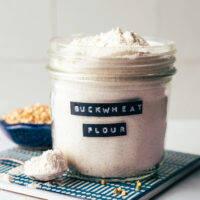
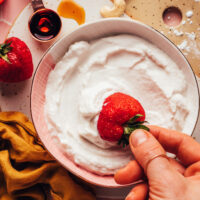
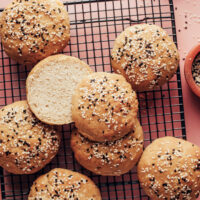
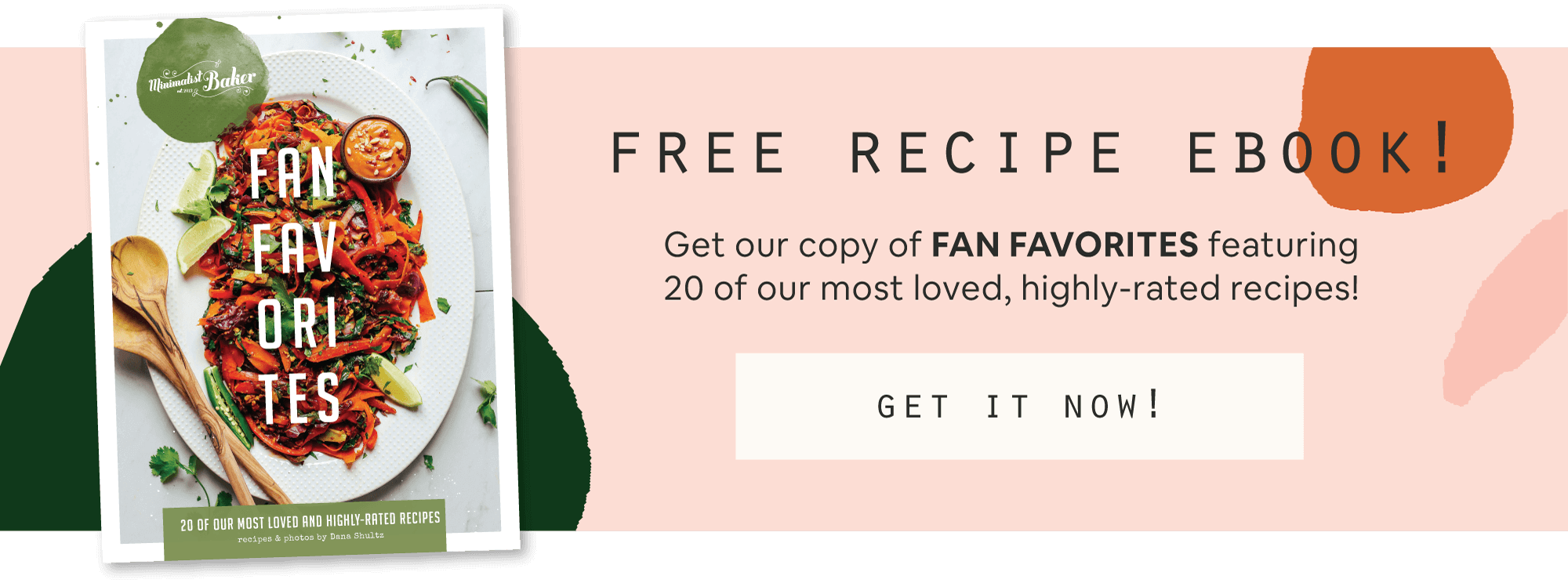
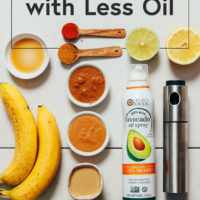
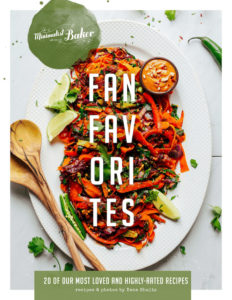
Cara says
Thank you so much for this guide! I don’t know if you mentioned this, but another idea for oil- free salad dressings/dips is to use fat-free Greek yogurt ( just make sure to thin it out with some kind of liquid) or regular yogurt.
We’re so glad it’s helpful, Cara! Thank you for sharing! xo
Caroline says
Thank you for this lovely and educational article! I learned a lot about oils and how to minimise the use of them in my cooking, thank you! The idea of roasting veg in a light spritz of oil and maple syrup + spices sounds divine – I love doing that with my brocoli.
I would love to make a request – if I may! – for an article (or post, not sure what you call them) about how to bake with less sugar. I am always longing for desserts but I really want to have as little sugar as possible when baking. The thing is, I am CLUELESS 😳 when it comes to cutting down sugar in baking. If I want to reduce the amount of sugar in a cake (i.e 1 cup to 1/2 a cup), do I add more fat like oil or applesauce?
I’d love an article covering all this. That would be amazing. If you can’t, no worries! 🤗
Caroline xo
We’re so glad it was helpful, Caroline! Thank you for the suggestion! We’ll add it to our ideas list!
nvrm says
I find the recommendations to use coconut fat or nut butter or tahini misleading, they’re still mostly oils and still very high in calories.
Some of them are yes, but others like applesauce, vegetable broth, or water are low fat.
Laura Swain says
Such an incredibly helpful article and guide. Love your centrist approach that is relatable for everyone! Thank you for compiling all of this in one place! I tend to have a heavy hand with my oils and this is a great reminder that there are easy and effective substitutes to keep an eye on fat/caloric intake!
Thanks so much for sharing, Laura! We’re so glad you enjoyed this article!
Kelly Powers says
Very informative post with lots of tips – my favorite being the miso paste salad dressing. I also can’t wait to try your 5-minute liquid gold sauce. Thanks for sharing!
We’re so glad you think so, Kelly! Thanks so much for sharing!
Sarah says
Great article! Thank you!!
Irene says
Hands down the best nonstick safe cookware is Swiss Diamond. NOTHING sticks to it and it cleans like a breeze.
Thanks for sharing, Irene!
MS says
I second the Swiss Diamond rec!!
Sophie K. says
I regularly use tahini to roast vegetables in the oven. Just mix with a bit of water, salt, and spices to make a thinner paste, toss, and bake! It adds baking-enhancing fat with a whole food. Plus, the flavor is divine.
Love that idea! Thanks for sharing, Sophie!
Sarah Moore says
Thank you for this. I follow the Overcoming MS programme. The diet is low in saturated fat and oil is not used for cooking.
And I can definitely still make caramelised onions! I put sliced onions in a pan with a pinch of salt. The salt helps them to release their moisture. You can cook them like this for several minutes – then add a little water when it starts to stick. The Maillard reaction turns the sugars in the onions brown without needing any oil.
Thanks for sharing, Sarah! xo
Kyle says
So insightful, helpful, refreshing and visually stunning as are all of your articles. Thank you, really truly
Aw, so kind! Thanks for sharing, Kyle!
DJ says
Thank you for this post!!! I try to eat oil-free but fall off the wagon a lot, so this is very motivating. Plus I like that you emphasize options so it’s not all-or-nothing. P.S. I have experimented with chilled avocado in place of butter or vegan butter when baking biscuits and scones. It works. Might be something for you to try if you’re curious!
Love that tip! Thanks for sharing, DJ!
Teri K says
Thank you for this post. I find it very helpful, as my husband and I are on a low/no oil diet due to health concerns (heart disease and cancer). Your vegan sloppy joes and Shepard’s Pie are some of our favorites.
We’re so glad you found it helpful and enjoy those recipes, Teri! Thanks so much for sharing! xo
mary beth says
Thank you for the great informative article. We are a WFPB family and I occasionally use a little carefully chosen oil in our diet for many reasons also. Really loved this post and your recipes!
We’re so glad you enjoyed it, Mary Beth! Thanks for sharing!
Charlotte says
Get this. Table spoon of cornstarch, cup of water in sauce pan, stir, boil till creamy. Allow to cool. I use all the time in place of the oil in Good Season’s vinaigrette. Not the whole cup of course. Only what recipe call for. You’ll never miss the mouth feel of the oil. I’ve also tried it in other dressings. Surprising.
Thanks for sharing, Charlotte!
Suzi says
WOW…I mean just wow, I am inspired and looking forward to making some of these…thank you so much
Aw, yay! Enjoy, Suzi =)
Hannah says
This is super informative and interesting! However, I think it’s important to note (specifically with the salads) that your body needs some fat to absorb all those nutrients you’re eating! It wouldn’t be nearly as beneficial to eat all those vibrant colors without a little fat in the mix.
Thanks for sharing, Hannah! That’s a good point. Keep in mind this approach does not reduce whole food sources of fat (such as nuts, seeds, avocado, etc.).
Cora says
This is an INCREDIBLE post. I’ve been a fan for a long time and love your recipes, but this is such an informative, thorough and generous collection of information, ideas and resources. Thank you!!
We’re so glad you enjoy it, Cora! Thanks for sharing!
Molly says
Love this post! I have been cooking with low oil for a couple years now. It is totally doable! Don’t know why so many recipes, especially those for sautéing and such call for so much oil. My oil mister, nonstick pan and water help me cook successfully with very little oil. I use spices and vinegars and mustard to add flavor. Thanks for addressing this. Made your oil free black bean falafel the other day. Loved your tip about drying the beans first to make them crispy. Thanks!!
Thanks so much for sharing, Molly! xo
Hanusia says
Thanks for this guide and for your thoughtful approach, Dana. I really appreciate that you are not trying to fearmonger about ingredients, but acknowledging that there is not a scientific consensus and presenting multiple perspectives. More people should take that approach!
I am probably not going to eliminate oil from my diet anytime soon, but it certainly seems healthy to cut back on it a bit, so I will definitely be using some of these tips/recipes. Thank you!
Thanks so much for your feedback, Hanusia! xo